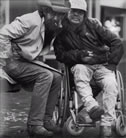Why poverty is worse than it was 30 years ago
By Jean Swanson
Twenty-five years after working as a community organizer with the Downtown Eastside Residents' Association in Vancouver, I've come back to the community as a retired person, volunteering at the Carnegie Centre.
One good thing about being older is that you have actually experienced a little history. I believe there are some lessons for policy-makers in what I can remember about the Downtown Eastside.
Thirty years ago, as now, the Downtown Eastside was a poor neighbourhood. Then, as now, people with addictions were visible on the street. In those days alcohol was the drug used most often. Now it's other drugs.
But 30 years ago the stores along East Hastings Street weren't boarded up. We bought newspapers at Universal News. Residents could afford a few breakfasts a month at the Princess Cafe, a hot plate at Benmors, a coconut bun at the local bakery, a cheap shirt at Fields, a coffee at the Two Eagles Cafe.
Three decades ago, city hall planners weren't spending hours on end trying to figure out how to get richer people to move to the area to "revitalize" businesses.
Why are so many storefronts in the Downtown Eastside boarded up? Look no further than government policies for a big part of the answer.
Low-income residents have lost a huge amount of purchasing power. Thirty years ago, as now, most Downtown Eastside residents depended on low-wage work, pensions, unemployment insurance or welfare for their income. The purchasing power of three of those sources of income has declined drastically.
In fact, if we want to know how to quickly revive business in the Downtown Eastside, just restore the spending power of the current residents to 1975 levels. That would pump about $2 million a month into the cash registers of the community.
In 1975 the minimum wage in British Columbia was 122 per cent of the poverty line for a single person in a city. Today the $8 an hour minimum wage is only 78 per cent of the poverty line for a 37.5-hour week.
To look at it another way, a single person would have to make $12.51 an hour at a full-time, 37.5-hour-a-week job to have the same purchasing power as a minimum-wage worker had in 1975. A person who depends on today's $6 an hour so-called training wage will make only 58 per cent of the today's poverty line with a full-time minimum-wage job.
Today, about 30 per cent of Downtown Eastside residents get their income from welfare, according to the city. Welfare for a single person whom the ministry considers employable is a maximum of $510 a month -- $185 for support and $325 for shelter. In 1981, the support portion of welfare was $205. To have the same purchasing power as it had in 1982, the welfare support allowance would have to be $355.48 today. The current shelter portion of welfare is so low that most people have to use their food money for rent.
If the current welfare rate were raised to provide the same purchasing power as it did in 1989, there would be about $763,000 per month more purchasing power in the Downtown Eastside!
Before 1996, the federal Canada Assistance Plan made provinces provide welfare to people in dire need. In 1996, CAP was abolished. Today, numerous welfare rules and procedures effectively deny welfare to people in dire need. Two major studies have said that this is the main reason homelessness has doubled since 2002. Homeless people have virtually no purchasing power.
Can the Downtown Eastside be "revitalized" if provincial and federal policies create dire poverty and homelessness on the streets while city policies lure in people who can afford quarter-million-dollar condominiums?
In the book The Impact of Inequality, Richard Wilkinson, professor of social epidemiology at the University of Nottingham medical school, quotes study after study to show that great inequality destroys community, undermines democracy, fosters illness, makes learning difficult for poor students and increases despair, alienation and street crime.
The way to "revitalize" our community would be to restore purchasing power to the low-income residents who live here: Raise welfare rates, end the barriers to getting on welfare and boost the minimum wage.
Jean Swanson is a former President of NAPO and a volunteer at the Carnegie Centre.
